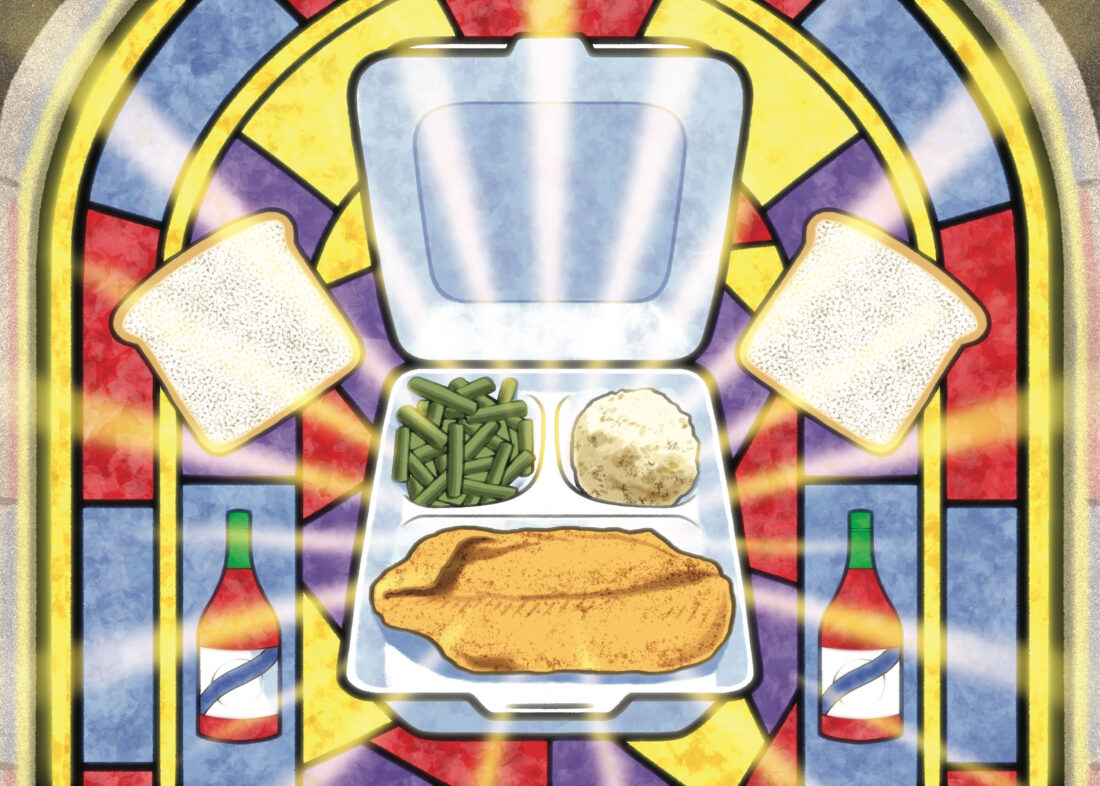Every year, at about 5:00 p.m. on the Tuesday that falls forty-seven days before the Sunday after the first full moon on, or after, the vernal equinox—which is to say, Mardi Gras Day—for about fifteen minutes, I get depressed. Carnival, the greatest of all seasons in New Orleans, is about to end. The weeks of drinking, eating, parading, costuming, dancing, and communing are suddenly coming to a close. Goodbye glitter, goodbye good times, hello (sad trombone)…Lent.
Then again (I think, after a few minutes of gloom): Helloooo Lent! Because that’s when I remember: I love Lent!

Technically, this is an inappropriate reaction. Lent, which runs from Ash Wednesday until sundown on Holy Thursday, is meant to be a solemn observance, forty days of commemorating Jesus Christ’s time of fasting and temptation in the desert through contemplation and abstention. Though I am not a Catholic, one of my favorite things about making my home in New Orleans has been yielding to the city’s liturgical cycles: a time of reflection following a time of revelry, a season of restraint following one of excess, to everything turn, turn, etc. For all the fun of Carnival, it’s a truism that Ash Wednesday always arrives right on time—for your aching feet, your aching liver, and also for your spiritual health, whatever your religion may be.
But let’s be honest. I love Lent because of the fried fish.
To start way back: From the first century until the middle of the twentieth, Catholics around the world were required to abstain from eating meat on Fridays. In 1966, Pope Paul VI amended that restriction to just Ash Wednesday and Good Friday. (Decades later, you still see vestiges of the old rule in Friday seafood specials at restaurants and on school lunch menus—Fish Stick Fridays!—even if many people have no idea why.) That same year, the National Conference of Catholic Bishops in the United States added a prohibition on Fridays during Lent for its church members.
Thus was born the tradition of Lenten fish fries, put on by churches and other affiliated groups to help the observant stay on the righteous path while also raising a little money. You can find fries in Catholic enclaves across the country, especially in the Midwest and Northeast, but there is unsurprisingly something special about the custom as practiced in New Orleans. Last year, the list of area fish fries compiled annually by the Archdiocese of New Orleans ran to sixty-six events, held by churches from All Saints to Visitation of Our Lady. The classic offering is a white Styrofoam clamshell, containing one or two pieces of fried fish and some combination of potato salad, macaroni and cheese, string beans, peas, and the like. You also usually get a plastic baggie containing a piece of sheet cake, brownie, or other dessert; a can of soda; and slices of white bread. The pro move is to douse your bread with the bottle of hot sauce by the cashier to improvise a sandwich later.
Some New Orleans fish fries branch out beyond strictly fish or fry. They offer dishes like shrimp and okra, seafood gumbo, craw-fish jambalaya—even such exotics as fish tacos and seafood muffulettas. In 2010, a local parishioner wrote to the archbishop of New Orleans to clarify whether alligator meat was permissible for Lent; coincidentally, the letter writer was an employee at the Insta-Gator Ranch & Hatchery, in St. Tammany Parish. The archbishop wrote back that, yes, alligator is Lent approved because it is “considered in the fish family,” something that may come as a surprise to reptile biologists. Nevertheless, to my knowledge, alligator has not made it onto the circuit.
Truth be told, the fries are staffed by volunteers of varying degrees of culinary aptitude and attention. Some meals are better than others. The real pleasure of the season is the opportunity to visit spaces to which you usually wouldn’t have access. I’ve munched fish in the cafeteria of a Catholic elementary school in St. Bernard Parish; in a wood-paneled den of a Knights of Columbus chapter across the river in Algiers; in the parking lot behind St. Augustine Catholic Church, the nearly two-hundred-year-old predominantly African American church in the heart of Tremé (New Orleans has one of the highest percentages of Black Catholics among major cities); and even on the sidewalk outside a onetime bail bonds office, across from the city jail, at the fry held by the First 72+, a nonprofit dedicated to helping formerly incarcerated people reenter society. This chance to peek inside the lives of my neighbors, to support them and be fed by them, is why I never get overly upset by a piece of fish that’s too salty or a portion of less than optimal mac and cheese. Besides, the worst piece of fried fish with hot sauce on white bread still makes for a pretty happy Friday afternoon. And over the years, I’ve found my way into some spectacular afternoons.
Personally, the fish fry that I think of on Mardi Gras Day, the one that lifts my spirits in advance of Ash Wednesday, is the one held by the Knights of Columbus Gentilly Council No. 2925 at St. James Major Catholic Church. You will know this fish fry by the large tents set up on the sidewalk, and by the line of hungry supplicants that often stretches around the block. For a city that is generally segregated on Sundays, both customers and volunteers are a notably diverse crowd. It is not uncommon to see folks heading off with four or five plates to bring to their families or coworkers.
That volume is surely part of what makes the fish so good. Often it is still too fresh from the fryer to eat without burning your fingertips on the crisp jacket of breading, seasoned to a level that teeters perfectly on the fulcrum between spiced and spicy. Not that the temperature ever stops me; I have never made it past the church steps before digging in.
The culinary genius behind the Gentilly fry is a fifty-nine-year-old floral design company manager named Darren Isabelle, who joined the Knights of Columbus in 2007. Isabelle says the recipe came from a former grand knight of the organization who happened to also own a branch of a local seafood restaurant chain. It starts out by dunking the fish fillets in a bath of diluted hot sauce and mustard. They are then dusted in a mixture of corn flour, cornmeal, and seasoning, and dropped into hot peanut oil. “It’s nothing proprietary or crazy. You can even do it at home,” Isabelle says, underestimating, like all great chefs, the gifts of intuition, experience, and attention. It’s Isabelle’s eyes that recognize the moment the amber bubbles cradling each fillet in the fryer slow down to the trickle that announces perfect doneness. It’s his obsessiveness that has him constantly checking the fish fry mix because he knows that more corn flour is lifted with each dredge than cornmeal or pepper, changing the balance as the day goes on.
According to current grand knight Terrence Johns, the Knights sell somewhere between eight hundred and a thousand pounds of fish, raising as much as forty thousand dollars for the church and other charitable organizations over the course of a five-week fry season (excluding Good Friday). The problem is that it’s become harder and harder to find enough volunteers to pull off that season; Johns says he needs at least twenty-five people to do the hard work of lugging around fryers, coolers, and so on. Two years ago, the Knights had to reduce their fry to every other week; in 2023, they canceled it altogether. At fifty-one, Johns is one of the youngest members of Council No. 2925—part of a churchwide crisis of shrinking and aging enrollment. In October, the archdiocese announced it would close or consolidate 10 percent of its parishes, including St. James Major, which is slated to merge with two other churches.
Still, Johns is intent on getting the fish fry back off the ground. He says the merger should help increase his labor force and that he’s confident this year’s Lent will once again bring the lines out to Gentilly Boulevard. For this, I offer an earnest hallelujah: If not for God, if not for the church, then at least for my post–Mardi Gras blues and all those who find heaven in a nice piece of fish.








